
Atlas F1 Senior Writer
Alongside on-track racing, Formula One is as much about the off-track politicking and regulation challenges. Seeing the competition decided in court has become very much a fixture of this sport as pit stops or on-track passing. But how do the wheels of justice really turn in Formula One? How did it work in the case of Jordan and Jarno Trulli at the 2001 US Grand Prix? Or in the case of Michael Schumacher and the Benetton team in 1994?
Atlas F1's Thomas O'Keefe brings an unprecedented study on the FIA's justice system and its very own Court of Appeal. In a four part feature, he reveals never-before-published evidence on how this unique system works
Another famous coming together that was a precursor to Jerez 1997 and that also determined the outcome of a Championship occurred in the Senna/Prost era - once in 1989 and once in 1990, both times at the Japanese Grand Prix at Suzuka.
The Japanese Grand Prix, on October 22nd 1989, was the next to last race of the season and the way the points were running, Senna had to win in both Japan and Australia to beat Prost. If neither McLaren driver won in Japan, then Prost would become World Champion.
Senna was on pole position at Suzuka, but Prost got the better start. On lap 46 of the 53 lap race, Senna decided to make his move and attempted to pass Prost on the inside at the chicane, in a maneuver much like that of Villeneuve at Jerez. Although not quite as blatant as Schumacher, Prost turned in none too subtly on Senna's overtaking maneuver and the two cars collided at relatively slow speeds under braking and came to a stop side by side, just a few feet apart.
Prost calmly got out of his McLaren, knowing he was World Champion. Characteristically, Senna was shaking his fists at Prost and at the corner marshals and wasn't giving up. He got a push-start from the marshals through the escape road that paralleled the chicane and rejoined the race. Incredibly, Senna stopped in the pits for a new nose and wing assembly and yet still somehow managed to get back into the race and crossed the finish line ahead of Alessandro Nannini in the Benetton-Ford, his fist upraised righteously and pounding the air, thinking his Championship hopes were still alive.
But the race officials disqualified Senna - not for the crash with Prost, but for taking the short-cut through the chicane - and took away his victory, thus confirming Prost's World Championship. Ron Dennis was in an impossible position since one of his drivers wanted to appeal the decision of the Stewards - Senna - while the other was quite happy with the outcome.
As often happened in that era, it was known that competitors who appealed often found that FISA turned the screws further, increasing the severity of the punishment almost as if to punish the competitor for having the insolence to appeal. In Senna's case, FISA looked back to his history of past infractions and he was given a six-month suspended ban and fined $100,000. Senna was furious and held a press conference to give his side of the story. This is what he said:
But cooler heads prevailed and when the first race of the 1990 season was held, Senna was back in his McLaren. But Prost had fled McLaren for Ferrari in 1990 and the two renewed their struggle for the 1990 World Championship. Suzuka again was a pivotal race and Senna's McLaren was on pole and Prost's Ferrari was right next to him on the front row. The points were such that the tables were turned from the prior year: if neither Senna nor Prost finished, Senna would win the title.
Senna adopted a take no prisoners attitude at the start and zoomed up inside of Prost's Ferrari at the very first turn and punted him off, catching the Ferrari on the right rear wheel. In an icy moment, Senna methodically got out of his car and walked back down the main straight to the pits with a I-hated-to-do-it-but-it-had-to-be-done look on his face and, at a distance, Prost did the same thing.
No one was punished this time and Senna was declared World Champion, the Ultimate Payback. Small wonder that Michael Schumacher complains that he is misunderstood over the Jerez incident, which was far less blatant in character than the provocateur's actions in either of these two episodes, Prost in 1989 and Senna in 1990, both of which went unpunished.
Possibly recognizing that the whole Team Orders issue needed clarification after the Williams/McLaren collaboration of Jerez 1997 and after the Grand Prix of Australia in 1998, when the McLaren team arranged for Coulthard to give way to Hakkinen when the two cars were running 1-2 to cure an internal team mistake, the FIA took up the matter again early in the 1998 season. Still sounding a bit like the Delphic Oracle, the World Council managed to find a statutory basis in the Sporting Code upon which to base the rule of thumb announced by the FIA on March 18th 1998:
The World Council is informing the Stewards of all future international events that "any act prejudicial to the interest of any competition" should in [the] future be penalized severely in accordance with Article 151c of the International Sporting Code."
On July 27th 1998, the World Council amplified on the Team Orders rule that governs to this day:
Two competitions are taking place simultaneously at each Formula One Grand Prix: the World Championship, which extends over sixteen races, and the individual race itself. It is perfectly legitimate for a team to decide that one of its drivers is its Championship contender and that the other will support him. What is not acceptable, in the World Council's view, is any arrangement which interferes with a race and cannot be justified by the relevant team's interest in the Championship, or any arrangement between teams.
Should a case occur, it will be judged on its facts and in the light of longstanding motor sport tradition."
Now are we crystal clear on that for next season!
Any sensible quasi-judicial system always has a mechanism to deal with issues short of litigation on the merits up to and including the International Court of Appeal. In the case of the FIA, this mechanism is the Eleventh Hour Withdrawal of the Appeal.
Although Max Mosley studiously asserts that he keeps out of the affairs of the International Court of Appeal, just after the Suzuka race ex-Barrister Mosley offered some avuncular free legal advice: he advised the Williams team and Villeneuve to withdraw their appeal against the disqualification because if it went forward Jacques could lose not only the 2 points from the Japanese Grand Prix but would also risk suspension for the last race of the season, which would mean not being able to challenge Schumacher and Ferrari for the World Championship.
As it was, after winning the next to last race, the Japanese Grand Prix, Schumacher held a one-point lead over Villeneuve going into the European Grand Prix at Jerez. Mosley was public and blunt about it: "I can imagine that [Villeneuve] will only lose the two points [already lost in Suzuka] if he withdraws his appeal." Which is exactly what happened as Williams and Villeneuve took the hint and folded their tent, withdrawing the appeal.
The race at Jerez was held on October 26th 1997, and the rest is history. Although Max Mosley had not seen eye to eye on certain "freedom of expression" issues during that same Summer of 1997, Jacques should be thanking his lucky stars that he and Craig Pollock and Frank Williams listened to Mosley that time around.
We have already seen how Jarno Trulli and Jordan Grand Prix shrewdly used the absence of a Steward at Indianapolis in 2001 to nullify Trulli's disqualification from fourth place for a skid block infraction, thus boosting Jordan ahead of arch-rival BAR-Honda in the Constructors' standings. In effect, Jordan used a technicality in the FIA rules to advance its interests, quite legitimately, even though it was only about who would finish in fifth place in the standings for 2001.
Apparently, Minardi was arguing that the team which registered the Footwork chassis did not actually own the chassis at the time and that Jackie Oliver was not authorized to sign the entry form. The Stewards let Footwork race in Australia and Minardi appealed from that decision.
In the Court of Appeal's discussion of the case, the Court noted that "the situation is even further complicated by the fact that the Footwork team participated in the F1 World Championship during the 1993 season and that under the name of this same team a different team seems to have participated in the 1994 F1 World Championship." If true, the Court of Appeal observed, "the consequences would be very grave." On December 19th 1994, the Court ordered a hearing for January 16th 1995 at the FIA headquarters in Paris to sort the matter out.
At the hearing, the Court of Appeal took evidence as if it was a trial court sitting in the first instance. The chief witness was "Mr. Keith Jack Oliver, then Director General of Arrows Grand Prix International Limited . . . . and of Footwork Limited."
Jackie Oliver had been a driver of note in his day: a winner of Le Mans in 1969 in the Ford GT 40, driver of the Shadow sports car in the Can-Am series and a Formula One driver episodically from 1967 through 1977. The Oliver/Arrows/Footwork case turned on the fact that when the entry form was signed on November 10th 1993, Jackie Oliver, who owned Arrows, was still in the process of negotiating to take over the rights to Footwork but the actual transfer of rights was not formalized until January 7th 1994 and April 26th 1994.
Thus, when the entry form was signed in November, Oliver did not yet own Footwork, "a circumstance which seems to have decided Arrows Grand Prix International Limited to enter their team under the name 'Footwork' . . . whereas it was in fact Arrows . . . who participated in the events of the World Championship . . .during the entire 1994 season [and] who used the Footwork chassis, in conformity with the submitted entry form."
Having untangled the web of intrigue, the Court of Appeal concluded that "however regrettable the situation . . . fraud does not seem to have been committed" and that there was no malicious intent to enter an ineligible automobile for the 1994 season. In effect, the Court of Appeal found an infraction of Article 70 of the International Sporting Code but did not nullify the Footwork entry and left it up to the FIA to discipline Footwork/Arrows further. Subsequently, having heard Jackie Oliver's explanations, the FIA imposed "a reprimand on the Arrows team" as the proportionate sanction for what occurred.
In the end, Footwork/Arrows, having shown remorse, retained their 9th place position in the constructor standings for the 1994 season (out of 11 teams) and Minardi finished in 10th place, unable to capitalize on the irregularities uncovered to improve upon the team's position. Only Larrousse finished behind Minardi that year. It is ironic that the only win for Arrows in Formula One thus far was in the courtroom.
While the Jarno Trulli episode at Indy 2001 reflects flawed administration by the Stewards of a race, it was a mild departure by comparison to the chaotic British Grand Prix at Silverstone on July 12th 1998, which ended under horrible conditions of torrential rain, with a "stop and go" penalty to Michael Schumacher's Ferrari coming in during the late stages of the race - the implementation of which went considerably awry.
In a dramatic moment that was an exquisite and eerie scene in its own way, Schumacher swept into his pit box on the last lap, crossing the finish line in the pit lane, to serve out his stop and go penalty and win the race then and there in the pits, with his engine running, helmet on and the rain pelting down the nose of the victorious but stationary Ferrari.
On lap 43, during the Safety Car/yellow flag period, Schumacher passed Alexander Wurz's Benetton (which was one lap down) while the yellow flag was out. On lap 57 of the 60 lap race Schumacher was notified that he was required to come into the pits and serve a 10-second stop and go penalty for overtaking under a yellow flag. At this point, he was only 18.7 seconds ahead of Hakkinen so had Schumacher come in, he surely would have lost the race.
Ferrari believed it had a three lap window in which to make the stop and go and chose to bring Schumacher in at the end of the last lap, winning the race by Schumacher's Ferrari passing the finish line in the pit lane (the finish line "is a single line which crosses both the track and the pit lane" according to the rules) before Hakkinen passed the finish line out on the track 22 seconds later.
The FIA agreed with Ferrari. According to the World Council's subsequent findings on the matter dated July 29th 1998, following McLaren's protest, it turned out that the constable had blundered again, with the Stewards making several mistakes in reporting the incident to the Race Director and to Ferrari in violation of the F1 Sporting Regulations on Communications to Competitors, Rules 50-56.
As a result, the investigation of and imposition of the stop and go penalty did not appear on the TV monitors throughout the pit lane as the rules contemplate (Rule 54(b)) and the Notice of Penalty to Ferrari failed to note the time at which, and the lap on which the alleged incident took place. In sum, a result, in the FIA's words, "the wrong rule was applied and was applied outside the permitted time." In other words, it was a disaster.
Charitably, the World Council report on this incident noted "that all of the above took place when extreme weather conditions had placed race control under considerable stress."
Nevertheless, the affair was such a fiasco that the Stewards felt compelled to fall on their swords. As the World Council reports it: "In the circumstances all three Stewards have returned their Formula One Stewards' Super Licenses to the FIA." Interestingly, one of the Stewards that day at Silverstone in 1998 was none other than Canadian Roger Peart - the same Steward who had gone missing at Indianapolis in 2001 for the Trulli skid block infraction.
In defense of Roger Peart (lawyers call this factors in mitigation of damages), although he was somehow missing at 5 P.M. or so when it came time to have a look at Jarno Trulli's skid block fasteners, Peart is a man who knows a thing or two about racing and has given much to the sport.
Roger Peart is President of ASN Canada and also active in the FIA's Karting officialdom. More significantly, Peart, a former racecar driver himself and an engineer by training, was given the task of designing the Circuit Gilles Villeneuve in Montreal on the Ile Notre-Dame in November 1977, and amazingly the track was ready for the 1978 Canadian Grand Prix.
It is said that the Montreal track was made from the earth excavated from the construction of Montreal's subway system. In storybook fashion, that first race was won by Montreal's native son, Gilles Villeneuve, in a Ferrari. For designing the Senna hairpin after the pit straight and "Champion's Wall" just before the pit straight, Peart ought to be forgiven for his trespasses at Indy and Silverstone.
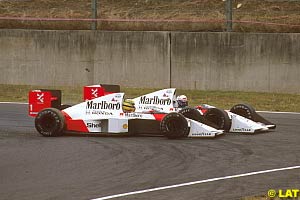 In 1989, Ayrton Senna and Alain Prost were both on the McLaren-Honda team and all year long had proved to be an unruly duo for Ron Dennis to control. A war of words had been going on between the two drivers since Imola in April, when Senna took the first corner contrary to a pre-race agreement with Prost that whoever got the better start would have the right to lead. Whatever the merits of the argument over Imola, it got ugly and the rhetoric escalated as the year unfolded, with Prost accusing both McLaren and Honda of favoring Senna, who was known to get on with the Honda mechanics.
In 1989, Ayrton Senna and Alain Prost were both on the McLaren-Honda team and all year long had proved to be an unruly duo for Ron Dennis to control. A war of words had been going on between the two drivers since Imola in April, when Senna took the first corner contrary to a pre-race agreement with Prost that whoever got the better start would have the right to lead. Whatever the merits of the argument over Imola, it got ugly and the rhetoric escalated as the year unfolded, with Prost accusing both McLaren and Honda of favoring Senna, who was known to get on with the Honda mechanics.
"I never caused the accident in Suzuka. It was never my responsibility and that you should see in a video not in my own words. The way the whole affair has been treated is like I have total responsibility for everything that took place there. I was blamed for everything. And I was penalized for everything. I was treated like a criminal. What we see today is truly a manipulation of the 1989 Championship."
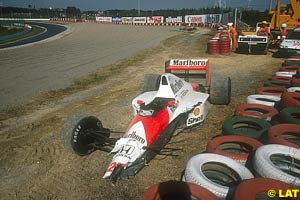 Jean Marie Balestre, then the President of FISA, demanded an apology from Senna since Senna was insinuating that Balestre had somehow "thrown" the Championship to fellow Frenchman Prost, and Balestre even threatened to pull Senna's Super License before the 1990 season began.
Jean Marie Balestre, then the President of FISA, demanded an apology from Senna since Senna was insinuating that Balestre had somehow "thrown" the Championship to fellow Frenchman Prost, and Balestre even threatened to pull Senna's Super License before the 1990 season began.
"Team Orders: The World Motor Sport Council has noted what happened at the 1998 Australian Grand Prix and during certain World Championship rallies.
"There has been considerable misunderstanding of the World Motor Sport Council decision of 18 March 1998 relating to team orders. There is no prohibition of team orders as such. The World Council merely reminded competitors of the longstanding provisions of Article 151c of the International Sporting Code, which prohibit 'any act prejudicial to the interest of any competition' and made it clear that any such act would be penalized.
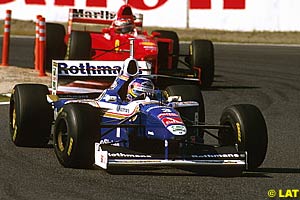 As an example, just before the pivotal Jerez 1997 race, the Japanese Grand Prix at Suzuka was held on October 12th 1997. At the Japanese Grand Prix, Jacques Villeneuve was penalized for ignoring a yellow flag during Saturday Practice and was disqualified from the race, although he was ultimately permitted to race while the matter was on appeal. Schumacher won the race and Villeneuve would have finished fifth and garnered two points had he not been disqualified because of the penalty. The appeal from the yellow flag violation would have been scheduled for Tuesday, October 21st 1997, just a few days before practice for the Jerez race that would determine the World Championship.
As an example, just before the pivotal Jerez 1997 race, the Japanese Grand Prix at Suzuka was held on October 12th 1997. At the Japanese Grand Prix, Jacques Villeneuve was penalized for ignoring a yellow flag during Saturday Practice and was disqualified from the race, although he was ultimately permitted to race while the matter was on appeal. Schumacher won the race and Villeneuve would have finished fifth and garnered two points had he not been disqualified because of the penalty. The appeal from the yellow flag violation would have been scheduled for Tuesday, October 21st 1997, just a few days before practice for the Jerez race that would determine the World Championship.
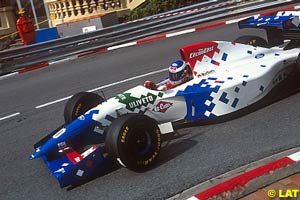 Towards the end of the 1994 season, a similar attempt was made by Giancarlo Minardi to boost the little Minardi team from Faenza up in the Constructors' Championship standings vis-a-vis its nearest competitor, Footwork Grand Prix International Limited. Minardi protested Footwork's participation in the 1994 Australian Grand Prix, claiming that when Jackie Oliver signed the FIA entry form for the 1994 season, on November 10th 1993, the declaration he made in the form was "fraudulent" and "should be considered null and void."
Towards the end of the 1994 season, a similar attempt was made by Giancarlo Minardi to boost the little Minardi team from Faenza up in the Constructors' Championship standings vis-a-vis its nearest competitor, Footwork Grand Prix International Limited. Minardi protested Footwork's participation in the 1994 Australian Grand Prix, claiming that when Jackie Oliver signed the FIA entry form for the 1994 season, on November 10th 1993, the declaration he made in the form was "fraudulent" and "should be considered null and void."
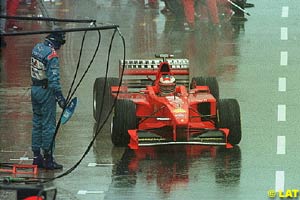 Schumacher trailed Hakkinen in the 1998 World Championship standings going into the British Grand Prix and a victory at Silverstone would finally put him on top. But Hakkinen held the lead throughout much of the race despite being chased by the Regenmeister, that is until the yellow flags and the Safety Car came out, allowing Schumacher to put pressure on Mika after the restart.
Schumacher trailed Hakkinen in the 1998 World Championship standings going into the British Grand Prix and a victory at Silverstone would finally put him on top. But Hakkinen held the lead throughout much of the race despite being chased by the Regenmeister, that is until the yellow flags and the Safety Car came out, allowing Schumacher to put pressure on Mika after the restart.
Next week: the Malaysian Millimeter Muddle, and a look at the future of racing justice
Please Contact Us for permission to republish this or any other material from Atlas F1.
|
Volume 8, Issue 7
Articles
The FIA's Court of Appeal: Part III
Speed Limits
Columns
Rear View Mirror
Bookworm Critique
The Weekly Grapevine
> Homepage |